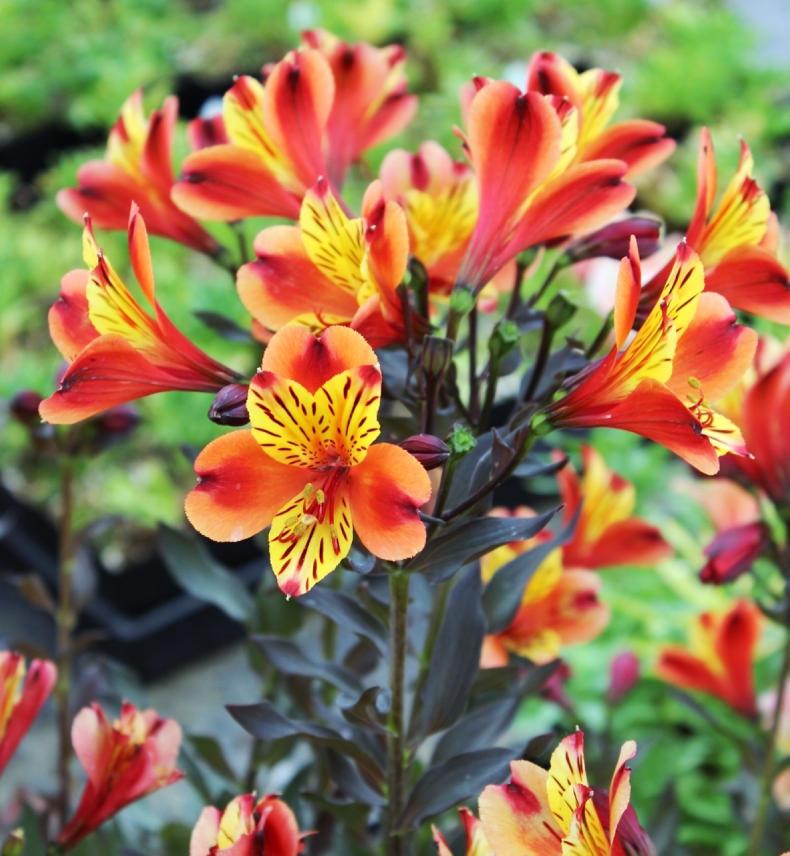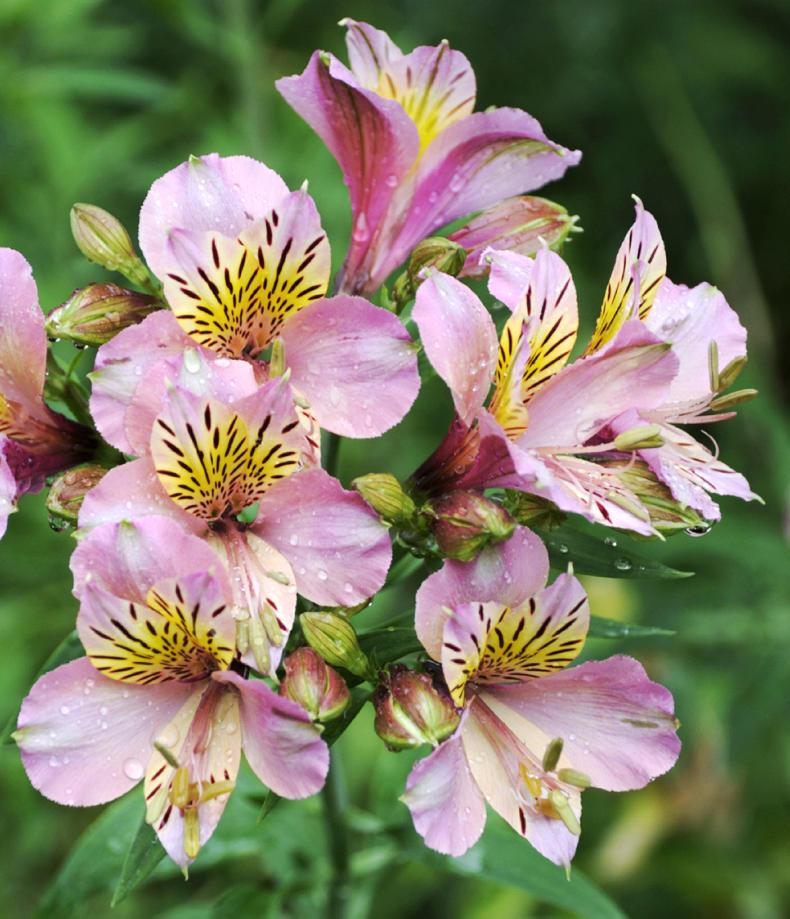Twenty years ago, nobody would have believed you if you stated that plants just 30cm tall could carry full-size Peruvian lily flowers, and flower repeatedly all summer. But they have been around for a few years now and have been rapidly acquiring many new fans. People who had their patience worn thin began to revise their opinions. One fatal flaw was that Peruvian lilies used to flop about and collapse in a swathe, usually at flowering time. The lower kinds have rectified that annoying problem.
The second problem was that they were routinely attacked by slugs and snails. Unlike the flopping propensity, this problem remains. The slugs’ taste for them is widely known. Damage is done mainly at shoot emergence and when the plants get well-established, like dahlias, they physically out-grow what the snails can eat. It is almost as though slugs have not evolved in South America, or that the juicy leaves are irresistible to the slimy hordes.
While the common name claims this flower for Peru, and there are some species that occur in that country, the most commonly grown kinds are natives of Chile and Argentina. But like practically all South American plants, no matter which country they are native to, the flowers are distinctively coloured in brilliant shades of orange, red, flame-pink and yellow. These colours are most attractive to humming-bird pollinators and much of South America’s flora has evolved for pollination by this agent rather than insects. The flowers are broadly lily-shaped with lots of greenish or brown spots in the throat of the flower and prominent pollen-bearing anthers.

Alstroemeria 'Indian summer'.
The most commonly grown orange-coloured Alstroemeria aurea is a fairly rampant grower, spreading outwards, by creeping roots. It needs to be given a good amount of space to make a large clump and can be bounded by shrubs or strong perennials to keep it in bounds. Many kinds have been produced such as Ligtu hybrids and Princess hybrids. They can be grown from seeds and considerable variation of colour may result as the mixed colour parentage is expressed. ‘High Society Mix’ offers a lovely range of yellow, peach and cream, growing to about 60cm and grown from seed. ‘Indian Summer’ is one of the most showy with red-orange flowers over bronze foliage, from plants. ‘Inca Bandit’ is a short grower, used as a colourful pot plant in a range of brilliant colours: red, yellow, pink, salmon, white, orange and light purple.
Growing from seed is an easy way to start off a batch of plants with heat in February. It is quite common to see clumps of alstroemerias with flowers of several colours showing. These arise from individual plants which are grown in a pot and simply planted out en masse in a border. The seedlings can be gently teased apart but the roots are so flashy, soft and brittle that considerable damage can be caused, which is why people do not risk it and plant the lot. However, it is possible to take divisions of existing plants, but this must be done carefully, taking whole spadefuls, unbroken, or else very gently teasing out the fleshy roots and potting them or planting them. The best time for division is when the early autumn dormancy arrives, when they are least easily damaged.
Choose a good sunny spot for alstroemerias so that they will be centre-stage in July when they flower – they deserve a prominent position because they are so showy. The ground should be fertile, soft, well manured and not inclined to dry out but well-drained too and certainly not prone to winter water logging, which would kill the roots. The Peruvian lily, sometimes grandly called the ‘lily of the Incas’ is borderline hardy and can suffer damage in frosty districts but mostly does fine in gardens, but may need to be covered with loose material in winter in a cold locality. The newer varieties are claimed to be hardier. Some very fancy kinds need to be greenhouse-grown, which is how they are grown as top-quality cut flowers, the petals produced indoors being unmarked. But be careful about growing them in a greenhouse or tunnel – they will want to take over!

Alchmilla.
Flowering these days in its distinctive shade of yellow-green, the lady’s mantle, Alchemilla mollis, is a remarkably good plant for a country garden. The tufts of rounded leaves and the straggling flowering stems provide good ground cover and this plant can look after itself. It even self-sows quite freely and new plants will find their way into suitable positions. Some might say it is too generous and can colonise places where it is not wanted. So be careful not to plant it too close to borders where it might become a nuisance. On the other hand, for semi-wild areas along the base of shrubs and trees, it is superb and can be left to get on with it.
Fruit, vegetables and herbs
Potato blight control should be kept up, especially for maincrop potatoes. The early varieties will generally be used up before the disease does damage to the tubers. Remove vegetables that have gone over such as the first sowing of lettuce. Herbs are ready for picking and preserving by drying or freezing.
Flowers
Plants in containers of all kinds will need frequent watering, every second day or even every day for small containers if the weather is hot and dry. Feeding is also essential and can be given in every third or fourth watering, if slow-release fertiliser was not used at potting up.
Lawn
Around the country, lawns have recently got a good mixture of moisture and sunshine and are mostly looking well. Heavy lightning storms of a few weeks ago had the effect of greening grass as the nitrate formed is washed from the air. Soil moisture levels had fallen but rain has arrived before its effects started to show on the grass.
Trees, shrubs and roses
The return of moist weather has seen an upsurge in blackspot and leaf spot disease on roses, if they were not sprayed. Spraying susceptible kinds is necessary in broken weather. Soil moisture has been adequate to keep young trees growing. It is time to clip hedges of all kinds before the wood gets tough.
Greenhouse and house plants
Continue watering and feeding greenhouse plants. Be especially careful to water plants in pots or grow-bags regularly, because these can easily dry out. Cuttings of shrubs of all kinds can be taken now, first deciduous kinds and later in a few weeks the evergreen sorts. Train and side-shoot tomatoes and cucumbers.
Read more
In the garden with Gerry Daly: mulling over mulleins
In the garden with Gerry Daly: classy Kalmia
Twenty years ago, nobody would have believed you if you stated that plants just 30cm tall could carry full-size Peruvian lily flowers, and flower repeatedly all summer. But they have been around for a few years now and have been rapidly acquiring many new fans. People who had their patience worn thin began to revise their opinions. One fatal flaw was that Peruvian lilies used to flop about and collapse in a swathe, usually at flowering time. The lower kinds have rectified that annoying problem.
The second problem was that they were routinely attacked by slugs and snails. Unlike the flopping propensity, this problem remains. The slugs’ taste for them is widely known. Damage is done mainly at shoot emergence and when the plants get well-established, like dahlias, they physically out-grow what the snails can eat. It is almost as though slugs have not evolved in South America, or that the juicy leaves are irresistible to the slimy hordes.
While the common name claims this flower for Peru, and there are some species that occur in that country, the most commonly grown kinds are natives of Chile and Argentina. But like practically all South American plants, no matter which country they are native to, the flowers are distinctively coloured in brilliant shades of orange, red, flame-pink and yellow. These colours are most attractive to humming-bird pollinators and much of South America’s flora has evolved for pollination by this agent rather than insects. The flowers are broadly lily-shaped with lots of greenish or brown spots in the throat of the flower and prominent pollen-bearing anthers.

Alstroemeria 'Indian summer'.
The most commonly grown orange-coloured Alstroemeria aurea is a fairly rampant grower, spreading outwards, by creeping roots. It needs to be given a good amount of space to make a large clump and can be bounded by shrubs or strong perennials to keep it in bounds. Many kinds have been produced such as Ligtu hybrids and Princess hybrids. They can be grown from seeds and considerable variation of colour may result as the mixed colour parentage is expressed. ‘High Society Mix’ offers a lovely range of yellow, peach and cream, growing to about 60cm and grown from seed. ‘Indian Summer’ is one of the most showy with red-orange flowers over bronze foliage, from plants. ‘Inca Bandit’ is a short grower, used as a colourful pot plant in a range of brilliant colours: red, yellow, pink, salmon, white, orange and light purple.
Growing from seed is an easy way to start off a batch of plants with heat in February. It is quite common to see clumps of alstroemerias with flowers of several colours showing. These arise from individual plants which are grown in a pot and simply planted out en masse in a border. The seedlings can be gently teased apart but the roots are so flashy, soft and brittle that considerable damage can be caused, which is why people do not risk it and plant the lot. However, it is possible to take divisions of existing plants, but this must be done carefully, taking whole spadefuls, unbroken, or else very gently teasing out the fleshy roots and potting them or planting them. The best time for division is when the early autumn dormancy arrives, when they are least easily damaged.
Choose a good sunny spot for alstroemerias so that they will be centre-stage in July when they flower – they deserve a prominent position because they are so showy. The ground should be fertile, soft, well manured and not inclined to dry out but well-drained too and certainly not prone to winter water logging, which would kill the roots. The Peruvian lily, sometimes grandly called the ‘lily of the Incas’ is borderline hardy and can suffer damage in frosty districts but mostly does fine in gardens, but may need to be covered with loose material in winter in a cold locality. The newer varieties are claimed to be hardier. Some very fancy kinds need to be greenhouse-grown, which is how they are grown as top-quality cut flowers, the petals produced indoors being unmarked. But be careful about growing them in a greenhouse or tunnel – they will want to take over!

Alchmilla.
Flowering these days in its distinctive shade of yellow-green, the lady’s mantle, Alchemilla mollis, is a remarkably good plant for a country garden. The tufts of rounded leaves and the straggling flowering stems provide good ground cover and this plant can look after itself. It even self-sows quite freely and new plants will find their way into suitable positions. Some might say it is too generous and can colonise places where it is not wanted. So be careful not to plant it too close to borders where it might become a nuisance. On the other hand, for semi-wild areas along the base of shrubs and trees, it is superb and can be left to get on with it.
Fruit, vegetables and herbs
Potato blight control should be kept up, especially for maincrop potatoes. The early varieties will generally be used up before the disease does damage to the tubers. Remove vegetables that have gone over such as the first sowing of lettuce. Herbs are ready for picking and preserving by drying or freezing.
Flowers
Plants in containers of all kinds will need frequent watering, every second day or even every day for small containers if the weather is hot and dry. Feeding is also essential and can be given in every third or fourth watering, if slow-release fertiliser was not used at potting up.
Lawn
Around the country, lawns have recently got a good mixture of moisture and sunshine and are mostly looking well. Heavy lightning storms of a few weeks ago had the effect of greening grass as the nitrate formed is washed from the air. Soil moisture levels had fallen but rain has arrived before its effects started to show on the grass.
Trees, shrubs and roses
The return of moist weather has seen an upsurge in blackspot and leaf spot disease on roses, if they were not sprayed. Spraying susceptible kinds is necessary in broken weather. Soil moisture has been adequate to keep young trees growing. It is time to clip hedges of all kinds before the wood gets tough.
Greenhouse and house plants
Continue watering and feeding greenhouse plants. Be especially careful to water plants in pots or grow-bags regularly, because these can easily dry out. Cuttings of shrubs of all kinds can be taken now, first deciduous kinds and later in a few weeks the evergreen sorts. Train and side-shoot tomatoes and cucumbers.
Read more
In the garden with Gerry Daly: mulling over mulleins
In the garden with Gerry Daly: classy Kalmia











SHARING OPTIONS